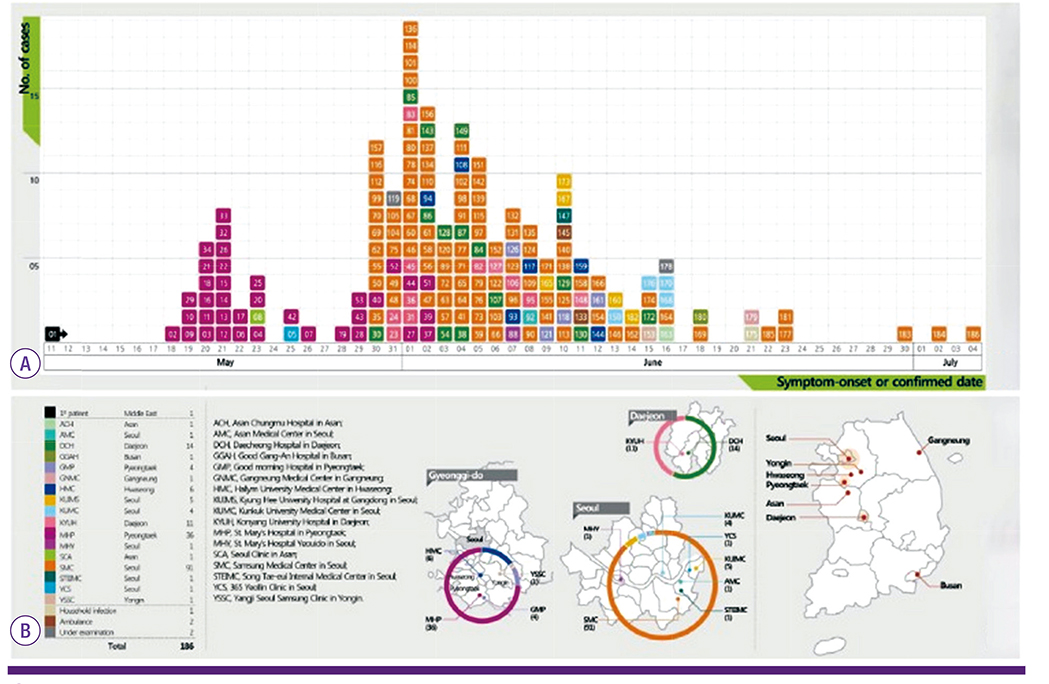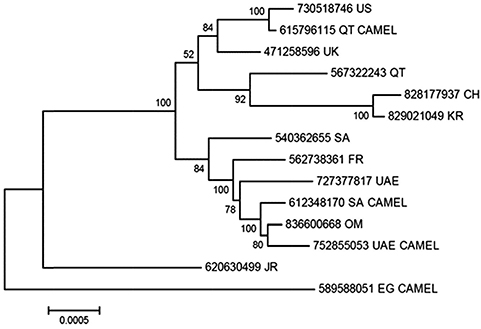Infect Chemother.
2016 Jun;48(2):75-80. 10.3947/ic.2016.48.2.75.
Institutional Preparedness to Prevent Future Middle East Respiratory Syndrome Coronavirus-Like Outbreaks in Republic of Korea
- Affiliations
-
- 1Division of Infectious Diseases, Department of Internal Medicine, Soonchunhyang University Cheonan Hospital, Cheonan, Korea.
- 2Division of Infectious Diseases, Department of Internal Medicine, Soonchunhyang University Seoul Hospital, Soonchunhyang University College of Medicine, Seoul, Korea. geuncom@schmc.ac.kr
- KMID: 2327974
- DOI: http://doi.org/10.3947/ic.2016.48.2.75
Abstract
- A year has passed since the Middle East respiratory syndrome (MERS) outbreak in the Republic of Korea. This 2015 outbreak led to a better understanding of healthcare infection control. The first Korean patient infected by Middle East Respiratory Syndrome Coronavirus (MERS-CoV) was diagnosed on May 20, 2015, after he returned from Qatar and Bahrain. Thereafter, 186 Korean people were infected with the MERS-CoV in a short time through human-to-human transmission. All these cases were linked to healthcare settings, and 25 (13.5 %) infected patients were healthcare workers. Phylogenetic analysis suggested that the MERS-CoV isolate found in the Korean patient was closely related to the Qatar strain, and did not harbor transmission efficiency-improving mutations. Nevertheless, with the same infecting virus strain, Korea experienced the largest MERS-CoV outbreak outside the Arabian Peninsula, primarily due to the different characteristics of population density and the healthcare system. We aimed to review the epidemiological features and existing knowledge on the Korean MERS outbreak, and suggest methods to prevent future epidemics.
MeSH Terms
Figure
Reference
-
1. Chowell G, Abdirizak F, Lee S, Lee J, Jung E, Nishiura H, Viboud C. Transmission characterisics of MERS and SARS in the healthcare seting: a comparative study. BMC Med. 2015; 13:210.
Article2. Durai P, Batool M, Shah M, Choi S. Middle East respiratory syndrome coronavirus: transmission, virology and therapeutic targeting to aid in outbreak control. Exp Mol Med. 2015; 47:e181.3. Kayali G, Peiris M. A more detailed picture of the epidemiology of Middle East respiratory syndrome coronavirus. Lancet Infect Dis. 2015; 15:495–497.4. Müller MA, Meyer B, Corman VM, Al-Masri M, Turkestani A, Ritz D, Sieberg A, Aldabbagh S, Bosch BJ, Lattwein E, Alhakeem RF, Assiri AM, Albarrak AM, Al-Shangiti AM, Al-Tawfiq JA, Wikramaratna P, Alrabeeah AA, Drosten C, Memish ZA. Presence of Middle East respiratory syndrome coronavirus antibodies in Saudi Arabia: a nationwide, cross-sectional, serological study. Lancet Infect Dis. 2015; 15:629.5. Weber DJ, Rutala WA. Risks and prevention of nosocomial transmission of rare zoonotic diseases. Clin Infect Dis. 2001; 32:446–456.6. van Doremalen N, Miazgowicz KL, Milne-Price S, Bushmaker T, Robertson S, Scott D, Kinne J, Mc-Lellan JS, Zhu J, Munster VJ. Host species restriction of Middle East respiratory syndrome coronavirus through its receptor, dipeptidyl peptidase 4. J Virol. 2014; 88:9220–9232.
Article7. Assiri A, McGeer A, Perl TM, Price CS, Al Rabeeah AA, Cummings DA, Alabdullatif ZN, Assad M, Almulhim A, Makhdoom H, Madani H, Alhakeem R, Al-Tawfiq JA, Cotten M, Watson SJ, Kellam P, Zumla AI, Memish ZA. KSA MERS-CoV Investigation Team. Hospital outbreak of Middle East respiratory syndrome coronavirus. N Engl J Med. 2013; 369:407–416.
Article8. Assiri A, Al-Tawfiq JA, Al-Rabeeah AA, Al-Rabiah FA, Al-Hajjar S, Al-Barrak A, Flemban H, Al-Nassir WN, Balkhy HH, Al-Hakeem RF, Makhdoom HQ, Zumla AI, Memish ZA. Epidemiological, demographic, and clinical characteristics of 47 cases of Middle East respiratory syndrome coronavirus disease from Saudi Arabia: a descriptive study. Lancet Infect Dis. 2013; 13:752–761.
Article9. Mailles A, Blanckaert K, Chaud P, van der Werf S, Lina B, Caro V, Campese C, Guéry B, Prouvost H, Lemaire X, Paty MC, Haeghebaert S, Antoine D, Ettahar N, Noel H, Behillil S, Hendricx S, Manuguerra JC, Enouf V, La Ruche G, Semaille C, Coignard B, Lévy-Bruhl D, Weber F, Saura C, Che D. investigation team. First cases of Middle East Respiratory Syndrome Coronavirus (MERS-CoV) infections in France, investigations and implications for the prevention of human-to-human transmission, France, May 2013. Euro Surveill. 2013; 18:pii:20502.
Article10. Perlman S, McCray PB Jr. Person-to-person spread of the MERS coronavirus--an evolving picture. N Engl J Med. 2013; 369:466–467.
Article11. Zumla A, Hui DS, Perlman S. Middle East respiratory syndrome. Lancet. 2015; 386:995–1007.
Article12. Bin SY, Heo JY, Song MS, Lee J, Kim EH, Park SJ, Kwon HI, Kim SM, Kim YI, Si YJ, Lee IW, Baek YH, Choi WS, Min J, Jeong HW, Choi YK. Environmental contamination and viral shedding in MERS patients during MERS-CoV outbreak in South Korea. Clin Infect Dis. 2016; 62:755–760.
Article13. The Disease Daily. MERS outbreak in South Korea. Accessed 24 April 2016. Available at: http://www.healthmaporg/site/diseasedaily/article/mers-outbreak-south-korea-6715.
Article14. Galvani AP, May RM. Epidemiology: dimensions of superspreading. Nature. 2005; 438:293–295.
Article15. Lloyd-Smith JO, Schreiber SJ, Kopp PE, Getz WM. Superspreading and the effect of individual variation on disease emergence. Nature. 2005; 438:355–359.
Article16. Stein RA. Super-spreaders in infectious diseases. Int J Infect Dis. 2011; 15:e510–e513.
Article17. Drosten C, Muth D, Corman VM, Hussain R, Al Masri M, HajOmar W, Landt O, Assiri A, Eckerle I, Al Shangiti A, Al-Tawfiq JA, Albarrak A, Zumla A, Rambaut A, Memish ZA. An observational, laboratory-based study of outbreaks of middle East respiratory syndrome coronavirus in Jeddah and Riyadh, kingdom of Saudi Arabia, 2014. Clin Infect Dis. 2015; 60:369–377.
Article18. Buchholz U, Müller MA, Nitsche A, Sanewski A, Wevering N, Bauer-Balci T, Bonin F, Drosten C, Schweiger B, Wolff T, Muth D, Meyer B, Buda S, Krause G, Schaade L, Haas W. Contact investigation of a case of human novel coronavirus infection treated in a German hospital, October-November 2012. Euro Surveill. 2013; 18:pii:20406.19. Mizumoto K, Endo A, Chowell G, Miyamatsu Y, Saitoh M, Nishiura H. Real-time characterization of risks of death associated with the Middle East respiratory syndrome (MERS) in the Republic of Korea, 2015. BMC Med. 2015; 13:228.20. Ki M. 2015 MERS outbreak in Korea: hospital-to-hospital transmission. Epidemiol Health. 2015; 37:e2015033.21. Korea Centers for Disease Control and Prevention (KCDC). National negative pressure inpatient beds expansion plans. Accessed 4 June 2016. Available at: http://www.nih.go.kr/CDC/cms/cmsFileDownload.jsp?fid=22&cid=65345&fieldName=attach1&index=1.22. Centers for Disease Control and Prevention (CDC). Interim infection prevention and control recommendations for hospitalized patients with Middle East respiratory syndrome coronavirus (MERS-CoV). Accessed 4 June 2016. Available at: http://www.cdc.gov/coronavirus/mers/infection-prevention-control.html.23. Laborplus. "I will probably die due to overwork rather that due to MERS.". Accessed 3 June 2016. Available at: http://www.laborplus.co.kr/news/articleView.html?idxno=9945.
- Full Text Links
- Actions
-
Cited
- CITED
-
- Close
- Share
- Similar articles
-
- An Unexpected Outbreak of Middle East Respiratory Syndrome Coronavirus Infection in the Republic of Korea, 2015
- Considerations Left behind Middle East Respiratory Syndrome Coronavirus (MERS-CoV) Outbreaks in Republic of Korea
- Ethical Perspectives on the Middle East Respiratory Syndrome Coronavirus Epidemic in Korea
- Institutional preparedness for infectious diseases and improving care
- Costly Lessons From the 2015 Middle East Respiratory Syndrome Coronavirus Outbreak in Korea



